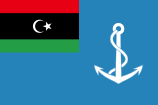Flag of Libya: Difference between revisions
streamlined text |
|||
| Line 12: | Line 12: | ||
| Image3 = Flag of Libya (1951).svg |
| Image3 = Flag of Libya (1951).svg |
||
| Use3 = 000000 |
| Use3 = 000000 |
||
| Symbol3 = {{FIAV|noflag}} |
| Symbol3 = {{FIAV|noflag}} Used by [[2011 Libyan protests|2011 protesters]], some embassies no longer supporting the [[Libyan government]], and by the [[National Transitional Council]]. |
||
| Design3 = Horizontal tricolor of red, black and green with white crescent and star in the center |
| Design3 = Horizontal tricolor of red, black and green with white crescent and star in the center |
||
}} |
}} |
||
Revision as of 22:23, 10 March 2011
 | |
| Use | National flag and civil ensign [1] |
|---|---|
| Proportion | usually 1:2 |
| Adopted | November 11, 1977 |
| Design | Green |
 | |
| Use | Naval ensign |
| Design | Light blue, with the green national flag in the canton and a white anchor with rope in the fly |
 | |
| Use | Other |
| Design | Horizontal tricolor of red, black and green with white crescent and star in the center |
The flag of Libya (Template:Lang-ar, Berber: Acenyal n Libya) (adopted on November 11, 1977) consists of a green field. It is the only national flag in the world with just one color and no design, insignia, or other details.[2] It was designed by Libyan leader Muammar al-Gaddafi.[3] Green reflects the predominant religion of Islam, and is also the official national color of Libya. It was adopted when Libya left the Federation of Arab Republics in 1977.
History
- 1918–1923
The short-lived Tripolitanian Republic in western Libya had its own flag, which had a light blue field and a green palm tree in the center, with a white star on top of it.[4]
- 1951–1969
The flag of the Kingdom of Libya was adopted when Libya gained independence in 1951 from Italy. It consisted of a white crescent-and-star on a triband red-black-green design, with the central black band being twice the width of the outer bands. The design was based on the banner of the Senussi dynasty from Cyrenaica, which consisted of a black field and crescent-and-star design, and was later used as the flag of the region. The red represented the region of Fezzan, while the green came from the banner of Tripolitania. The red could also symbolise the blood of the people, and the green the colour of Islam and a symbol of prosperity.[citation needed] The crescent and the star is a traditional symbol in many Muslim countries.[5] It was unanimously voted on by the tribes in Libya.[citation needed]
- 1969–1972
Following the coup d'état of 1969, the flag was replaced by the Pan-Arab red-white-black tricolor of the Arab Liberation Flag, first flown after the Egyptian Revolution of 1952 (which also formed the basis of the flags of Egypt, Iraq, Syria, and Yemen).
- 1972–1977
In 1972 when Libya joined the Federation of Arab Republics its flag was adopted by the country, linking it to Egypt and Syria. It featured a golden hawk (the "Hawk of Qureish"), holding a scroll with the Arabic name of the Federation.[6]
- 1977–
On November 11, 1977 following the country's official renaming as the Great Socialist People's Libyan Arab Jamahiriya, the flag was changed to the all-green design, in reaction to Anwar Sadat's visit to Israel. In addition to its symbolism in Islam, green is also symbolic of Gaddafi's "Green Revolution".
- 2011
During the 2011 uprising against the government rule of Muammar al-Gaddafi, the 1951–1969 flag – as well as various makeshift versions without the crescent and star symbol – came back into use in areas held by the Libyan opposition and by protesters at several Libyan diplomatic missions abroad.[7][8][9][10][11]
Flag gallery
Historical flags
-
Kingdom of Libya (1951–1969)
-
Libyan Arab Republic (1969–1972)
-
Libyan Arab Republic within the Federation of Arab Republics (1972–1977)
-
Great Socialist People's Libyan Arab Jamahiriya (1977-present)
-
Variant of 1951 flag with equal-height stripes, used by some 2011 protesters. Many similar makeshift versions are currently in use.
Regional flags
-
Historic flag of the emirate of Cyrenaica, 1949-1951
-
Historic flag of the Ottoman vilayet of Tripolitania, 1864-1911
See also
References
- ^ Libya at Flags of the World
- ^ "Libya Flag". Retrieved December 12, 2009.
- ^ "Staff of Libyan consulate in Egypt lower flag". Reuters.
- ^ "World Statemen-Libya". Retrieved December 12, 2009.
- ^ [http://flagspot.net/flags/ly_1951.html
- ^ Smith, Whitney; Buhrer, Emil (1975). Flags Through the Ages and Across the World. New York, New York: McGraw-Hill. p. 361. ISBN 978-0-07-059093-7.
{{cite book}}: Check|isbn=value: checksum (help) - ^ http://www.google.com/hostednews/canadianpress/article/ALeqM5gpm_i4gCtyuAXtsDYQrIX8zrJKHQ?docId=6029350
- ^ http://www.middle-east-online.com/english/?id=44543
- ^ http://english.aljazeera.net/indepth/spotlight/libya/2011/02/2011224123588553.html
- ^ Janathan S. Landay, Warren P. Strobel and Arwa Ibrahim (18 February 2011). "Violent repression of protests rocks Libya, Bahrain, Yemen". The Kansas City Star. Retrieved 19 February 2011.
- ^ Mark Tran (17 February 2011). "Bahrain in crisis and Middle East protests – live blog". The Guardian. Retrieved 19 February 2011.







